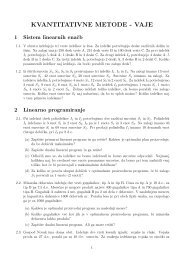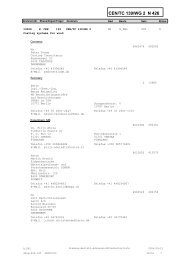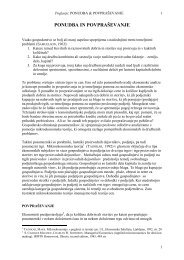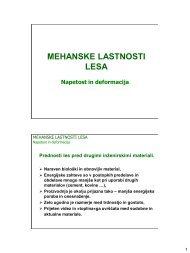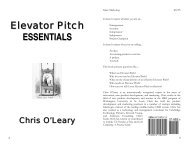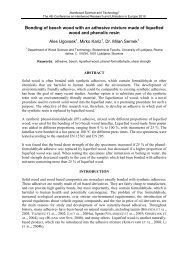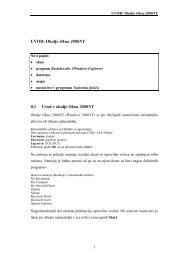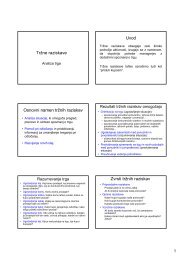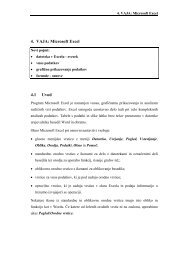Influence of carboxylic acids on fixation of copper in wood ...
Influence of carboxylic acids on fixation of copper in wood ...
Influence of carboxylic acids on fixation of copper in wood ...
- No tags were found...
Create successful ePaper yourself
Turn your PDF publications into a flip-book with our unique Google optimized e-Paper software.
ched. Leach<strong>in</strong>g <str<strong>on</strong>g>of</str<strong>on</strong>g> these specimens resulted <strong>in</strong> a <strong>copper</strong> loss <str<strong>on</strong>g>of</str<strong>on</strong>g> 48.2%, which iscomparable with the results determ<strong>in</strong>ed accord<strong>in</strong>g to the standard procedure(Humar et al. 2003). This result c<strong>on</strong>firms that modificati<strong>on</strong> <str<strong>on</strong>g>of</str<strong>on</strong>g> the method didnot significantly <strong>in</strong>fluence the leach<strong>in</strong>g rates compared to the standard procedure.<str<strong>on</strong>g>Influence</str<strong>on</strong>g> <str<strong>on</strong>g>of</str<strong>on</strong>g> <str<strong>on</strong>g>carboxylic</str<strong>on</strong>g> <str<strong>on</strong>g>acids</str<strong>on</strong>g>The most important c<strong>on</strong>tributi<strong>on</strong> <str<strong>on</strong>g>of</str<strong>on</strong>g> the present research is the elucidati<strong>on</strong> <str<strong>on</strong>g>of</str<strong>on</strong>g><str<strong>on</strong>g>carboxylic</str<strong>on</strong>g> acid’s <strong>in</strong>fluence <strong>on</strong> <strong>copper</strong> leach<strong>in</strong>g from preserved <strong>wood</strong> (Table 1).It is reported that from the impregnated <strong>wood</strong> treated with <strong>copper</strong>/ethanolam<strong>in</strong>esoluti<strong>on</strong>, between 15 and 22% <str<strong>on</strong>g>of</str<strong>on</strong>g> <strong>copper</strong> was leached (Humar et al.2003). Additi<strong>on</strong> <str<strong>on</strong>g>of</str<strong>on</strong>g> <str<strong>on</strong>g>carboxylic</str<strong>on</strong>g> <str<strong>on</strong>g>acids</str<strong>on</strong>g> decreased the leech<strong>in</strong>g <str<strong>on</strong>g>of</str<strong>on</strong>g> <strong>copper</strong> fromimpregnated <strong>wood</strong> significantly. Am<strong>on</strong>g different <str<strong>on</strong>g>carboxylic</str<strong>on</strong>g> <str<strong>on</strong>g>acids</str<strong>on</strong>g> and am<strong>in</strong>es,comb<strong>in</strong>ati<strong>on</strong> <str<strong>on</strong>g>of</str<strong>on</strong>g> octanoic acid and ethanolam<strong>in</strong>e was found the most effective.From <strong>wood</strong> impregnated with preservative soluti<strong>on</strong> CuEa6O1B, 2.0% <str<strong>on</strong>g>of</str<strong>on</strong>g> <strong>copper</strong>was leached. However, if we <strong>in</strong>creased the c<strong>on</strong>centrati<strong>on</strong> <str<strong>on</strong>g>of</str<strong>on</strong>g> octanoic acid <strong>in</strong>preservative soluti<strong>on</strong> <strong>copper</strong> fixati<strong>on</strong> was even better. Chemical analysis <str<strong>on</strong>g>of</str<strong>on</strong>g>leach<strong>in</strong>g soluti<strong>on</strong>s revealed, that <strong>in</strong> <strong>wood</strong> treated with CuEa6O1B preservative,98.4% <str<strong>on</strong>g>of</str<strong>on</strong>g> <strong>copper</strong> rema<strong>in</strong>ed after leach<strong>in</strong>g (Table 1).The comb<strong>in</strong>ati<strong>on</strong> <str<strong>on</strong>g>of</str<strong>on</strong>g> octanoic acid with diethanolam<strong>in</strong>e also improved the<strong>copper</strong> fixati<strong>on</strong>, but not to such an extent as the specimens treated with <strong>copper</strong>/ethanolam<strong>in</strong>e/octanoic acid preservatives. For example, <strong>copper</strong> was leachedtwo times more <strong>in</strong> the soluti<strong>on</strong> Cu2Ea8O1B than <strong>in</strong> the similar soluti<strong>on</strong>(CuEa8O1B) where diethanolam<strong>in</strong>e was replaced by ethanolam<strong>in</strong>e (Table 1).2-Ethylhexanoic and decanoic <str<strong>on</strong>g>acids</str<strong>on</strong>g> were found less effective than octanoicacid, but these <str<strong>on</strong>g>acids</str<strong>on</strong>g> still decreased leach<strong>in</strong>g compared to the soluti<strong>on</strong>s <str<strong>on</strong>g>of</str<strong>on</strong>g> the<strong>copper</strong>/am<strong>in</strong>e without <str<strong>on</strong>g>carboxylic</str<strong>on</strong>g> <str<strong>on</strong>g>acids</str<strong>on</strong>g> (Humar et al. 2003). Mazela et al.(2003) reported that from Cu-ethanolam<strong>in</strong>e-quat impregnated <strong>wood</strong>, between6.6 and 14.9% <str<strong>on</strong>g>of</str<strong>on</strong>g> <strong>copper</strong> is leached. Comparable leach<strong>in</strong>g rates from Cu/am<strong>in</strong>etreated <strong>wood</strong> were reported <strong>in</strong> the paper <str<strong>on</strong>g>of</str<strong>on</strong>g> Zhang and Kamdem (2000) as well.Two types <str<strong>on</strong>g>of</str<strong>on</strong>g> reacti<strong>on</strong>s are proposed to take place between <strong>wood</strong> and <strong>copper</strong>/ethanolam<strong>in</strong>e/<str<strong>on</strong>g>carboxylic</str<strong>on</strong>g> complex; ligand exchange and complexati<strong>on</strong>. Complexati<strong>on</strong>reacti<strong>on</strong>s are str<strong>on</strong>ger and thus <strong>copper</strong> <strong>in</strong> this form is less pr<strong>on</strong>e toleach<strong>in</strong>g. These <strong>in</strong>teracti<strong>on</strong>s are str<strong>on</strong>gly <strong>in</strong>fluenced by the pH value <str<strong>on</strong>g>of</str<strong>on</strong>g> the<strong>copper</strong>–am<strong>in</strong>e complexes. At less basic pH values <str<strong>on</strong>g>of</str<strong>on</strong>g> the treat<strong>in</strong>g soluti<strong>on</strong>, morecomplexes <str<strong>on</strong>g>of</str<strong>on</strong>g> charged species are present. Hence, <strong>in</strong>teracti<strong>on</strong> between the <strong>wood</strong>and Cu/ethanolam<strong>in</strong>e complex is more likely and c<strong>on</strong>sequently Cu leach<strong>in</strong>g isreduced (Thomas<strong>on</strong> and Pasek 1997; Zhang and Kamdem 2000). This is <strong>on</strong>epossible explanati<strong>on</strong> for the reduced <strong>copper</strong> leach<strong>in</strong>g from the <strong>wood</strong> impregnatedwith soluti<strong>on</strong>s c<strong>on</strong>ta<strong>in</strong><strong>in</strong>g <str<strong>on</strong>g>carboxylic</str<strong>on</strong>g> <str<strong>on</strong>g>acids</str<strong>on</strong>g>, as preservative soluti<strong>on</strong>sc<strong>on</strong>ta<strong>in</strong><strong>in</strong>g <str<strong>on</strong>g>carboxylic</str<strong>on</strong>g> <str<strong>on</strong>g>acids</str<strong>on</strong>g> have lower pH values like the <strong>on</strong>es without <str<strong>on</strong>g>acids</str<strong>on</strong>g>.The other explanati<strong>on</strong> is that <str<strong>on</strong>g>carboxylic</str<strong>on</strong>g> acid and particularly octanoic acid hasa hydrophobic effect, or that there are certa<strong>in</strong> complexes formed betweenoctanoic acid and <strong>wood</strong> or ethanolam<strong>in</strong>e, which <strong>in</strong>fluence <strong>copper</strong> fixati<strong>on</strong>.<str<strong>on</strong>g>Influence</str<strong>on</strong>g> <str<strong>on</strong>g>of</str<strong>on</strong>g> am<strong>in</strong>esIn the described experiment, three different am<strong>in</strong>es were used; ethanolam<strong>in</strong>e,diethanolam<strong>in</strong>e and triethanolam<strong>in</strong>e (Table 1). The highest average leach<strong>in</strong>g689



